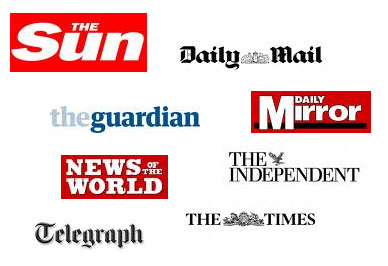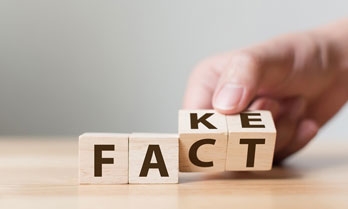
Our consumption of news contributes to our world view and social interactions and news should be there to inform us. However, over the years newspapers have morphed into opinion papers.
In addition, we tend to choose our news sources so that we read, hear and see stories with which we agree, creating a self-reinforcing echo chamber.
This is called “confirmation bias” and it is even more insidious in the modern world of the Internet and viral fake news. It encourages the formation of groups such as the pro Trump QAnon conspiracy believers and anti-vaxxers. None of us is immune.
Therefore, wherever you get your news, it is worth asking the following questions:
- How trustworthy are my news sources?
- How biased are they politically?
- Are they telling me news or opinions?
- How can I get close to the truth?
- How can I detect fake news?
Let us take a look at some of the news sources we regularly use, looking at the situation from the point of view of a British citizen living in Spain.
News Sources

1. Printed newspapers – the traditional source of news
Here in Spain we have The Daily Mail (for UK news), the Costa Blanca News, free news weeklies (Euronews, Olive Press etc.), Spanish newspapers and international weeklies such as Time magazine and The Economist.
The Daily Mail seems to be the only UK National newspaper which is printed and sold here these days and it is widely sold and read.
Unfortunately the Daily Mail is categorised as a “Questionable source” by Mediabiasfactcheck.com !
“A questionable source exhibits one or more of the following: extreme bias, consistent promotion of propaganda/conspiracies, poor or no sourcing to credible information, a complete lack of transparency, and/or is fake news. Fake News is the deliberate attempt to publish hoaxes and/or disinformation for profit or influence. Sources listed in the Questionable Category may be very untrustworthy and should be fact-checked on a per-article basis. “
This website analyses publications based on wording used. e.g. is it loaded, emotional and over the top? what are the sources? are there are stories from different points of view? is there a political ideaology? etc.
2. Online newspapers
Many British news papers are available on-line. Some are behind paywalls.
Here are some, with their political bias as categorised by https://mediabiasfactcheck.com/ .
- Daily Mail (Questionable source) !!,
- The Telegraph (right bias)
- Daily Express (right bias)
- The Times (right-centre)
- The Economist (least biased)
- Daily Mirror (left-centre)
- Independent (left–centre),
- The Guardian (left-centre),
Spanish news: e.g.
- El País (also in English) (left-centre); ABC (right-centre);
- Local on line news papers: e.g. Olive Press, Las Provincias, Xàbia al Día
- Dedicated news websites such as
- Xabia.com (Several languages) https://www.javea.com/en/
- La Marina Plaza (Spanish) https://lamarinaplaza.com
- Spain in English https://www.spainenglish.com
- The Local. https://www.thelocal.es
International: e.g. New York Times, China Daily, Spiegel International etc etc….
3. Radio :
- BBC World service (many different languages), Bay Radio.
- Online radio from broadcasting news providers (e.g. BBC, Sky) and newspapers: e.g. Times Radio. A joint operation between Wireless Group, The Times and The Sunday Times. Available via the Times website, and apps for iPhones and Android. https://www.thetimes.co.uk/radio
4. Television news channels (via Satellite, iptv and/or Spanish terrestrial)
It’s worth checking who owns each channel – are they State owned, owned by a media mogul?? This may give you an idea of potential bias.
- BBC News: Independent corporation – funded by license fee and sales of programmes (UK)
- CNN : Private media company (US)
- Sky : Sky Group, part of NBC Universal, a private company (US)
- France24: State owned – funded by license fee and subsidy (France) Broadcasts in Arabic, English, French and Spanish.
- Euronews: jointly owned by several European and North African public and state-owned broadcasting organizations and private company Media Globe Networks (HQ in France)
- Aljazeera : International media conglomerate funded through loans and grants, some from Govt of Qatar (Qatar) Broadcasts in Arabic and English.
- RT: Russia today – Russian state-controlled international television network funded by the federal tax budget of the Russian government
- RTV.es 24H: national state-owned public-service television broadcaster (Spain)
5. Streaming: Mostly on YouTube
- The International news broadcasters’ live streams and programme clips.
- Some live streaming of international conferences. e.g. the recent Climate conference on Earth Day 22nd April. (Only 2700 viewers – I guess most of those were journalists!)
- Documentaries and “news clips” of doubtful origin – these are a major source of fringe ideas conspiracy theories and political propaganda.
6. Websites of the international news broadcast companies (as above)
Visiting these gives you an idea of the different priorities of each news broadcaster and their different “takes” on each news story:
e.g. Main news headlines April 22nd 2121
- Biden announces US will Halve emissions by 2030 -BBC
- Oxygen shortages compound death toll as India confronts Covid 19 surge – France 24
- Some Delhi hospitals have no oxygen, says minister – Aljazeera
- We have to step up: US commits to slash greenhouse gas emissions by 50% by 2030 – Sky
- Biden announces ambitious climate goals in stark contrast to Trump – CNN
(RE: CO2 emissions, one asks the question – half of what?) ;.)
7. International News agencies:
Reuters, AFP etc.
All the above news sources are second hand. i.e. the news is being presented to you through the lens and bias of the journalists and newspaper organisation concerned. Often these days, news from these sources is opinion rather than news.
8. News aggregators:
News aggregators are sites/apps that collect content from various sources to present them to you in a personalised way for easy viewing. Hence your news is further filtered e.g.
- The Edge browser gives you a feed of news stories on its default Home page of MSN News. This becomes personalised if you log in with a Microsoft account. It also displays ads. https://microsoftnews.msn.com
- If you have an Android phone and Google account, Google will “feed” you personalised news stories through the Google app. The news is partially based on your searches and stories you have clicked on. (Google News is not available on a PC because of Spanish legal restrictions)
- Also:
- Flipboard (general news) https://flipboard.com
- Pocket (provides recommendations based on news stories you have saved) https://getpocket.com
- Rotten Tomatoes (films) https://www.rottentomatoes.com
- Metacritic (movies, TV, games) https://www.metacritic.com
9. News Blogs: News and Opinion
e.g Huffington Post, Mashable, Gizmodo, the Daily Beast.
Although they arer just blogs, they can be very influential.
https://www.lifewire.com/top-most-popular-blogs-3486365
We oldies have grown up with news which has been curated by newspaper editors, but things are very different now. We live in the 21st century, and people don’t trust these newspapers any more. To get closer to the truth, we need to go to the source material. Here is an educational video for young people from TED – we can learn from it too!
Video: How to choose your news – Damon Brown from TED – 4 mins 48 seconds
10.Social media
– as noted in the above clip, social media can get you closer to the truth, but also lead you astray! For example: It’s estimated that only twelve people are behind most of the anti-vaxxer disinformation you see on social media.
https://mashable.com/article/disinformation-dozen-study-anti-vaxxers
Here are examples of popular Social media sites where you will find fact and fiction:
- Facebook. e.g. Jávea connect, Town hall. – You can report “False Information” on Facebook.
- Twitter: unfiltered noise!
- Instagram: An American photo and video sharing platform – You can report Fake News on this.
- Reddit: Consists of online “communities” of people with similar interests. Members can post comments, links, images and videos for discussion Each community is known as a “Subred” and is moderated by volunteer members and Reddit algorithms which block dubious posts.
11. Gossip
E-mails and WhatsApps forwarded by friends and neighbours. These can sometime be fake scams sent out to frighten people. e.g. The “Martinelli Video” scare which has been doing the rounds for years.
Fake News

How can we determine if news is fake?
Be suspicious if it’s opinionated, emotional, sensational, political, over the top.
See: How to Identify Fake News from Ryerson University (US)
https://learn.library.ryerson.ca/fakenews/identify
Use fact check sites
- Snopes.com – Urban legends https://www.snopes.com/
- Politifact – US Politics https://www.politifact.com/
- Full Fact – UK Independent Fact Checking charity https://fullfact.org/
- Fact Check – Channel 4 TV https://www.channel4.com/news/factcheck
- Reality Check – BBC https://www.bbc.com/news/reality_check
- Media Bias / Fact Check – Checks media sources for bias and fake news https://mediabiasfactcheck.com/ (plagued by too many adverts!)
Do some sleuthing yourself and look for the original story.
- Copy and paste the dubious text into the Google search engine – Google may send you to fact check sites.
- Research the images and videos. Here’s a video from France 24, giving tips about detecting fake videos and images. It is aimed at the younger generation who usually get their news from social media on their smartphones: Truth or Fake? 2021 …we can all learn from this, whatever our ages
Finally: Don’t share anything unless you are SURE it’s true.
Christine Betterton-Jones, knowledge junkie
